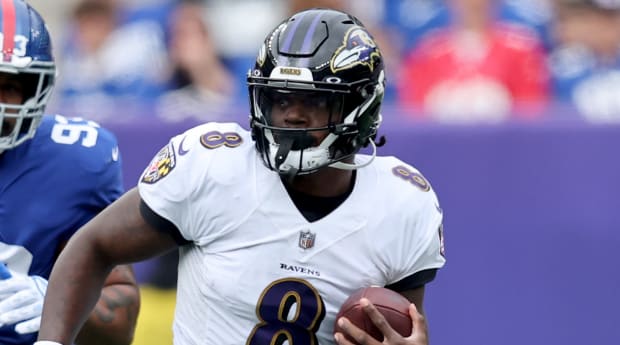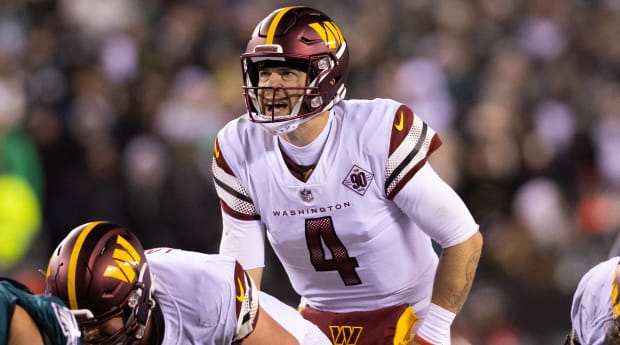New League Year, less than 24 hours away …
• When Lamar Jackson tweeted out that he’d been offered a fully guaranteed deal worth $133 million over three years, I think the for-now Ravens quarterback did more than blow off a little steam in what has to be a frustrating situation. To me, he sketched out what the compromise could be between him and Baltimore.
Now, for starters, I don’t know if his tweet should be interpreted as the full deal that was offered to him, or if it’s just where the guaranteed money is in a longer deal. And that’s very relevant in the grand scheme of things.
Here’s why—my educated guess is this is more about principle than money to Jackson. I know, I know. That sounds stupid, since Jackson has turned down nine-figure offers. Thing is, I think if this was about the money for him, especially after a couple of injury-riddled years, he’d have just taken the $100 million-plus fully guaranteed that was on the table and been done with all of this.
What I know is that he has been, with the help of the NFLPA and his mother, pursuing a fully guaranteed deal along the lines of what Deshaun Watson got. He’s been offered a top-of-the-market quarterback contract with a more traditional structure. The problem with that? On a traditional quarterback contract, there are routinely two or three years on the back end that are glorified team options and protect the team in the case of a catastrophic injury or downturn in play. Most quarterbacks can reasonably count on seeing that money.
Jackson’s case is different. Again, he’s finished the last two years on the shelf. He’s logged 753 carries in 65 career starts (including playoffs), which is an average of nearly 12 carries per game. That’s borderline unprecedented for a quarterback. Cam Newton, by comparison, was just under eight carries per game in 151 career starts. So if you’re Jackson, it’d be easy to look at that and say—You had me take on that workload, play my rookie contract out, and now you’re the one looking for injury protection on the back end?
So to me, the compromise would be the fully guaranteed, short-term deal. If Baltimore was willing to go to five years fully guaranteed, the deal would probably done. A more traditional offer would have, say, three years with guarantees on a five-year deal. Which means, to me, the middle ground would be to lop off the team-controlled back-end years, and give Jackson a no-tag provision. Say three years fully guaranteed, and then Jackson controls his free agency come 2026 at age 29.
That, to me, would protect both the team and player, and everyone could be on their way.
We’ll see what tomorrow afternoon holds.
Watch the Ravens with fuboTV. Start your free trial today.

Brad Penner/USA TODAY Sports
• I love the story of the 100th pick, which will, eventually, actually become a player.
It’s a compensatory pick that the Chiefs had in their back pocket this season, a reward (as part of the league’s effort to diversify its head coach and GM ranks) for Ryan Poles being hired from Kansas City’s front office to be the Bears general manager. Kansas City flipped it in the fall for former first-round receiver Kadarius Toney (who had a huge punt return in the Super Bowl). It was assigned a number last week, when comp picks were assigned, then flipped again from the Giants to the Raiders for veteran tight end Darren Waller.
We’ll see if the guy picked there becomes a Raider. If the last few months are an indication, you probably shouldn’t count on it.
VERDERAME: Giants’ Waller Trade Puts Spotlight Back on Kadarius Toney Deal
And while we’re here, it’s also worth noting that until a couple of years ago, teams couldn’t trade comp picks. That you can now, for the reasons illustrated above, has made them even more valuable in the minds of teams.
• So why does Waller get moved? And how did the Raiders only get a low third for him? He turns 31 in September. Injuries have cost him 14 games over the last two years. He’s coming off a 28-catch, 388-yard, three-touchdown season. And he was inherited by Josh McDaniels and Dave Ziegler. He’s also not cheap—due $12.475 million this year, $12 million next year, $13 million in 2025, and $15 million in 2026.
With that established, the Raiders also like Foster Moreau a lot, and we’ll see if they re-sign him (he’s a free agent). There’s also a historically deep tight end class in this year’s draft.
But I still think this is a very, very worthy swing by Giants GM Joe Schoen. The Giants had to put more around Daniel Jones, and with a pretty lackluster free agent class of receivers, bringing in a tight end who’s played at an elite level, even it’s been a couple of years since Waller was there, is absolutely something worth taking a shot on.
• The Raiders’ roster machinations are really interesting in that Vegas has focused on known commodities during the second offseason for McDaniels and Ziegler. In signing Jimmy Garoppolo and Jakobi Meyers, they get two guys they were with for three years (three-plus in Garoppolo’s case) in New England, adding to Chandler Jones, Jermaine Eluemunor and Duron Harmon (Harmon’s a free agent, but was a Raider last year) among the ex-Patriots.
The thought that Meyers could replace Waller’s pass-game production makes a lot of sense, and as was the case with Garoppolo, they’re not guessing on how he’ll fit in.
But the bigger picture piece here brings me back to a conversation I had with Jets coach Robert Saleh last summer. You’ll remember the well-publicized spat he and Rex Ryan had. What I found out after is that, when the two connected, Ryan actually gave Saleh some advice that Saleh took to heart.
“I was just asking him some questions,” Saleh said. “And he shared how when he got to the Jets, he brought on guys like Bart Scott, [Jim] Leonhard, all these guys he knew that would not only be champions of the message, flag-bearers, but also guys who understood his scheme and understood the style of play that they were looking for. He felt like that was such an instrumental part of his early success that, for us, it triggered thought—Hey, is it too late to take that same approach?”
So Saleh turned around last offseason and brought in Kwon Alexander, Laken Tomlinson, Marcell Harris and Solomon Thomas, and the results, at least until the quarterback situation melted down, followed. As I see it, what the Raiders are doing here is similar to that, and knowing what I know about the two, Garoppolo and Meyers will be good flag-bearers for the second-year GM and coach in Vegas.
• An interesting strategy we’ve seen from the Steelers in recent years (the Ravens and Patriots have done this too) showed its face again with the signing of Patrick Peterson—the signing of the third- or fourth-contract vet. Joe Haden, Myles Jack, and Melvin Ingram are other examples of it, with the benefit for teams being leadership, getting a known commodity (who’s already gotten his money, so there’s no projecting on how he’ll react to a big payday), institutional knowledge and, usually, a discounted price.
Peterson’s deal is for $14 million over two years, but Pittsburgh can easily bail from it after the 2023 season. Peterson gets $5.85 million to sign and a $1.3 million base salary this year, with a $3 million roster bonus creating a decision point for the team next March.
• Taylor Heinicke’s deal in Atlanta is a real one—the base value is $14 million over two years, and has incentives that could take it all the way to $20 million. It’s also an illustration of the strategy the Falcons are employing at the position—trying to stay economical so they can build the rest of the roster, and stay flexible for the time when a quarterback they’d be willing to go all-in on comes along. So Heinicke will compete with Desmond Ridder to start.
What the Falcons are doing, by the way, isn’t dissimilar from what you might see in Tampa and Washington this year, with young guys (Kyle Trask, Sam Howell) in both spots, and those teams picking a little too low to be in the mix for one of the first-round quarterbacks.

Bill Streicher/USA TODAY Sports
• There’s a strong belief in the league that the Texans are taking a quarterback second overall, strong enough to have influenced how the Bears approached trading down and how the Panthers approached trading up last week. So going and getting a veteran lineman in Shaq Mason was smart business, in that it helps solidify a group that really is rock solid across the board now. Which should give a young quarterback a great chance to grow.
• New Broncos RT Mike McGlinchey’s deal is a really good example of how to read a contract, and what it really means. McGlinchey’s getting a $17.5 million signing bonus, and his base salaries of $2.5 million this year and $15 million next year are fully guaranteed, bringing his guarantee at signing to $35 million. The twist from there is that the $17.5 million base he has for 2025 becomes fully guaranteed next March.
So, no, that’s not part of the full guarantee at signing. But realistically, the Broncos would have to pay $35 million for a single year of McGlinchey for that $17.5 million not to vest (that’d mean Denver cut him before mid-March 2024). Which is to say, he’s absolutely getting $52.5 million for three years, and that’s a pretty nice payday for a guy the Niners were willing to let go.
• I guessed it might be Baker Mayfield, it wound up being Sam Darnold, but the idea, to me, remained the same in San Francisco—bring in a guy with some upside to compete with Trey Lance until Brock Purdy gets healthy. It’ll be interesting to see Darnold in Kyle Shanahan’s quarterback-friendly offense, too. A big part of the issue with him has been that he doesn’t play fast enough, which coaches think is because he thinks too much out there.
The Niners offense, conversely, takes a lot of the mental load off the quarterback (the center makes the Mike identification calls, for example). So that should help Darnold, who’s getting $4.5 million in base pay for 2023 ($1 million of that in per-game roster bonuses), with another $7 million out there in incentives for him.
• One thing I feel good about two days in—my prediction that the linemen would gobble up all the money in this year’s free agent cycle. It has, indeed, been a boon for the big men.







